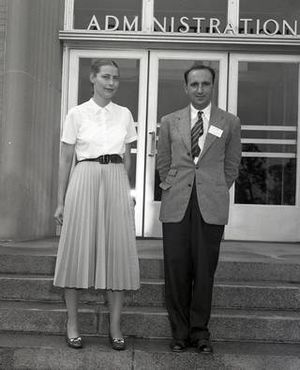Dorothy Martin Simon facts for kids
Dorothy Martin Simon (1919–2016) was a brilliant American scientist. She was a physical chemist who worked on aerospace combustion and created new polymers. Her work helped build heat shields and improve rocket engines for space travel.
She made important discoveries at places like NACA, which later became NASA. At DuPont, she helped create well-known synthetic materials like Dacron and Orlon.
Contents
Early Life and Education
Dorothy Martin was born on September 18, 1919, in Bacon Township, Missouri. Her parents were Laudell M. and Robert W. Martin.
She went to Southwest Missouri State University. Her father was the head of the science department there. Dorothy was the first student to get a perfect score (a 4.0 GPA) when she graduated.
After that, she studied at the University of Chicago for a year. Then she moved to the University of Illinois. She became an assistant to a professor there.
In 1945, she earned her PhD in physical chemistry from the University of Illinois. Her research was about radon. In 1946, she married Sidney Simon, a fellow student, and took his last name.
Amazing Scientific Discoveries
After getting her PhD, Dorothy Simon joined DuPont's Pioneer Research Lab. This was in Buffalo, New York. She worked on creating new catalysts. These are substances that speed up chemical reactions.
Her goal was to change the properties of synthetic polymers. This important work led to the creation of Dacron and Orlon. These are two widely used synthetic materials.
Exploring Radioactivity
After DuPont, Simon moved to Oak Ridge National Laboratory in Oak Ridge, Tennessee. Here, she made discoveries in radiochemistry. This is the study of radioactive materials.
She researched the triple-fission of uranium. This is when a uranium atom splits into three parts. She also found a new isotope of calcium. An isotope is a different form of an element.
For a short time, she continued similar research on uranium. This was at Argonne National Laboratory in Chicago, Illinois.
Improving Rocket Engines
In 1949, Simon began working at Lewis Research Center. This was a part of National Advisory Committee for Aeronautics (NACA). NACA was the organization that came before NASA.
She joined the fuels and combustion division. Combustion is the process of burning. She studied how fast flames moved and what types of fuel worked best for aircraft and rockets.
She also figured out the smallest tube size needed to keep an engine flame going. Her work led to many technical papers. It also greatly improved engine designs for airplanes and spaceflight.
Leading the Way for Women
Because of her great work at NACA, Simon received the Rockefeller Federal Service Award. This was a large grant of $10,000. She used the money to study more at the University of Cambridge in Cambridge, England.
She also traveled around Europe. She met with scientists in Germany, England, France, and Italy. She learned about their research in physical chemistry and radiochemistry.
When she returned, she was promoted. She became the assistant chief of NACA's combustion branch. This made her a pioneer in corporate management for women. Throughout the 1950s, she spoke up for women in science and education. She appeared on radio shows and in magazines.
After leaving NACA, Simon briefly worked at Magnolia Petroleum in Texas. There, she studied oil sands.
Developing Heat Shields
In 1956, Simon joined AVCO Corporation. This was a large aviation company in New England. She used her knowledge of polymers and chemistry. She helped create the technology for early aerospace heat shields.
These heat shields were vital for NASA's crewed spacecraft missions. This technology was famously used during NASA's Apollo program. Later, it was also used for ballistic missiles during the Cold War.
Simon stayed at AVCO for 30 years. She became a vice president and director of research. She was the company's first female corporate officer.
Awards
- Rockefeller Public Service Award (1953)
- Society of Women Engineers Achievement Award (1966)
- Businessweek’s list of 100 Top Corporate Women (1976)
Later Life and Legacy
Simon retired from AVCO when she was 65. She moved to Pittsboro, North Carolina. She then started her own consulting firm, Simon Associates. She ran it from her home until 1993.
Even after her research career, she continued to serve. She was on many committees and advisory boards. These included groups for government agencies, universities, and companies.
She was on the Department of Commerce Committee for the National Bureau of Standards. She also served on the committee for the National Medal of Science during the Carter administration.
Simon was the first female trustee at Worcester Polytechnic Institute. There, she created the Dorothy M. Simon Endowed Fund for Fire Safety Studies. This fund helps support research in fire safety.
Dorothy Simon passed away on March 25, 2016. She was 96 years old. She died at her home in Pittsboro, North Carolina.


